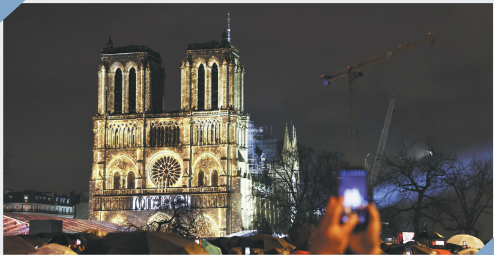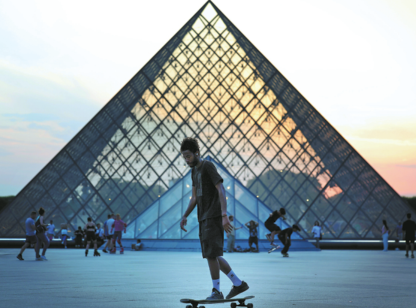Explore Paris from Notre Dame reborn
Cathedral's revival beckons visitors through the city's layered poetry, honoring the past and dancing toward the future

In December, the heart of Paris began to beat anew. Notre Dame Cathedral, one of the most beloved landmarks in the world, reopened to the public after five years of careful restoration.
Following the tragic fire in April 2019, which destroyed its roof and famous spire, the cathedral was left a shadow of its former self. Now, it rises again, reborn in stone, wood, and spirit.
The renovation was an extraordinary effort. More than 1,000 craftspeople, engineers, historians, and artisans from across France came together to restore the cathedral. They used traditional techniques from the Middle Ages, down to carpentry methods and limestone extraction. Two thousand oak trees were selected from sustainable forests to rebuild the roof's complex framework. Each was shaped and assembled to match the original design.
The roof that collapsed in 2019 was itself a 19th-century replacement, but it had become iconic. Historical drawings and modern 3D scans were employed to design a precise replica. It now soars to its rightful place in the Parisian skyline, gleaming with new copper and gold leaf detailing, its rooster-shaped weather vane proudly watching over the city.
Philippe Jost, head of the public agency Rebuilding Notre Dame, told the French newspaper Le Monde on Dec 1: "Although it's not the largest cathedral in France, it had a major influence on how others were built. We chose to rebuild it exactly as it was because the original design has stood the test of time."
Inside, the transformation is no less impressive.
Centuries of candle smoke and dust were gently cleaned from the stone walls. The stained-glass windows, including the magnificent rose windows, were carefully removed, restored, and replaced. The result is a brilliance of light that floods the nave, illuminating intricate stone carvings, restored paintings, and a new bronze altar.
A new reliquary for the Crown of Thorns, one of the cathedral's most sacred items, now sits in a quiet side chapel designed by modern artists with deep respect for tradition.
The cathedral is once again a place of worship and has become a symbol of resilience. Its reopening was marked by a powerful Mass attended by government leaders, global religious figures, and thousands of Parisians who had followed the reconstruction closely. Up to 30,000 visitors pass through its doors each day, many moved to tears by its resplendence.
Notre Dame has always been a mirror of Paris. Its walls have witnessed royal coronations, revolutionary battles, and quiet prayers. Its bells have rung out in celebration and mourning alike. And now, after a period of silence and scaffolding, it rings with life as it once did. But the journey through Paris does not stop at the cathedral's doors. It begins there.
To understand Notre Dame is to understand Paris itself. As with much in the city, it has endured layers of history — revolution, restoration, renewal. It connects generations, linking the medieval with the modern. As the cathedral rises from the ashes, it sets the tone for a city constantly balancing its past and present.
Even the smallest features of Notre Dame tell stories. The gargoyles that peer out over the city were never merely decorative; they were meant to guard against evil and to channel rainwater away from the stone. The bells, including the great Emmanuel bell in the south tower, are sounded only on major occasions. Above the newly restored and re-tuned grand organ, the Gallery of Kings reminds visitors of the cathedral's integral role in national identity.
Notre Dame's importance is more than architectural or historical. It is emotional. It has become a ubiquitous part of Parisian life — a space for reflection, celebration, mourning, and unity. For many, returning to Notre Dame is not just a tourist experience but a homecoming.
Sacred stones, streets
As visitors leave Notre Dame and step onto the stone pavements of the island where it stands, the city stretches out before them in all directions. The Seine River winds through its heart, connecting different faces of Paris like pages in a novel. Following the water offers a gentle introduction to the city's variety.
Crossing the bridge to the south bank, travelers soon find themselves in the Latin Quarter, once home to students and philosophers. Although the University of Paris no longer dominates the area as it once did, the bookshops, quiet gardens, and narrow alleys still echo with ideas and art. A few streets away, the shadow of the Pantheon falls across rooftops, its neoclassical dome hiding the tombs of France's great thinkers.
Following the river west leads to the Louvre Museum. Its glass pyramid stands at the center of a former royal palace. While its treasures are world-famous, it is the museum's connection to the city that matters most.
To call the Louvre merely a gallery is to undersell its status as a monument to Paris' place as a center of culture. Its layered architecture alone is a testament to centuries of transformation and taste. The vast courtyards and formal gardens behind it offer open space and reflection, a pause before continuing deeper into the city.
Moving further still, the streets lead to the Eiffel Tower. While it needs no description, it remains a constant presence — a beacon and a reminder of Paris' unique blend of daring design and enduring charm.
Bustling business district
For those curious about Paris' modern identity, the journey must continue to La Defense. Unlike the historic buildings of central Paris, La Defense looks forward, not back.
Just west of the city center, it is Europe's largest purpose-built business district. Spanning more than 3 million square meters of office space, it is home to 3,600 companies, including 15 of the world's top 50 firms, and houses 1,500 corporate headquarters. Each day, 180,000 employees work here, contributing to a dynamic ecosystem of commerce and innovation.
La Defense is also Europe's most significant public transport hub, seeing half a million passengers daily.
Around its towering glass structures lie 230,000 square meters of local shopping, 130,000 of which belong to the Quatre Temps shopping mall. Even here, art and beauty find a place. The Grande Arche mirrors the historic Arc de Triomphe but on a massive, modern scale. Its hollow center frames views of central Paris, aligning symbolically with its older twin. Dozens of public sculptures dot the plaza, including works by famous artists such as Alexander Calder and Joan Miro.
For tourists, La Defense provides surprises. Among them is the striking Japan Bridge, a pedestrian walkway designed by Japanese architect Kisho Kurokawa. Suspended 15 meters above a network of roads, it links the Pacific Tower and the Kupka building with a sleek design inspired by traditional Japanese bridges. Its red steel arches and glass vault create a light, futuristic silhouette — perfectly photogenic.
Easily accessed from Place du Dome near the Quatre Temps mall, it offers a unique vantage point for architectural photography and has become a favorite on Instagram for capturing the modern character of the district. Cafes, cinemas and rooftop bars keep the area lively well into the evening. Here, visitors discover a different side of Paris — one that embraces innovation while remaining inspired by its artistic roots.
The hill and the tower
From La Defense, a visitor might return to central Paris not through roads, but through stories. The city is a web of experiences rather than a straight line. And perhaps the next step is upward.
Montmartre, the hill in the north of the city, has long been a haven for artists and dreamers. In the 19th century, painters such as Toulouse-Lautrec and later Picasso made their homes here, drawn by low rents and high inspiration. The white dome of the Basilica of the Sacred Heart now marks the summit, a newer but no less meaningful place of worship than Notre Dame.
The steps of Montmartre are filled with life. In earlier times, the hill was crowned with more than a dozen windmills, which once formed the famous Moulin de la Galette. Today, only a few remain — Moulin Rouge being the most famous.
It is a great place to take photos, especially at night when the windmill and sign are lit up. If you have time, go and watch one of the world-famous cabaret shows at Moulin Rouge. Street artists sketch portraits in minutes. Cafes spill onto the sidewalks. Musicians play in the open air. The view from the top reveals Paris as layered, complex, and beautiful.
And there, in the distance, rises the Eiffel Tower. Although it is a sight so familiar, each glimpse carries a different story — from the families picnicking in its shadow to the couples watching it shimmer after dusk. It binds the city's fragments together. Standing beneath it, one feels the full magnitude of Paris' ambition and grace.
Widening the circle of exploration, visitors might journey to the outskirts of the city, where the grandeur of the Palace of Versailles awaits. Known for its gardens, mirrors, and history, it needs no elaborate introduction here. Suffice it to say, it completes the picture of Paris as a capital of grace and complexity. The sheer scale of its halls and the symmetry of its grounds still evoke the grandeur of a royal age.
A living landscape
Notre Dame's restoration has brought the eyes of the world back to Paris. What visitors find is a city alive with contrast and continuity. From the medieval stones of the island to the modern sculptures of La Defense, from the scholarly calm of the Latin Quarter to the lively slopes of Montmartre, Paris unfolds through time.
It is not a city to be rushed. One must be present in its landmarks to feel their place in the wider story: a narrative that is always being written, brick by brick, step by step.
As the bells of Notre Dame ring once more, they call out to the faithful. They ring for the curious, the beauty seekers and all who believe that cities can rebuild and rise from the ashes into something stronger, something lasting, something shared.



The writer is a freelance journalist for China Daily.
Today's Top News
- Xi's care and expectations for children
- China deplores US Defense Secretary's negative remarks
- China deplores US Defense Secretary's negative remarks
- ASEAN leader rejects US defense chief's confrontational rhetoric
- China refutes baseless accusations at Shangri-La Dialogue
- Xi on inheriting and promoting China's traditional culture






























